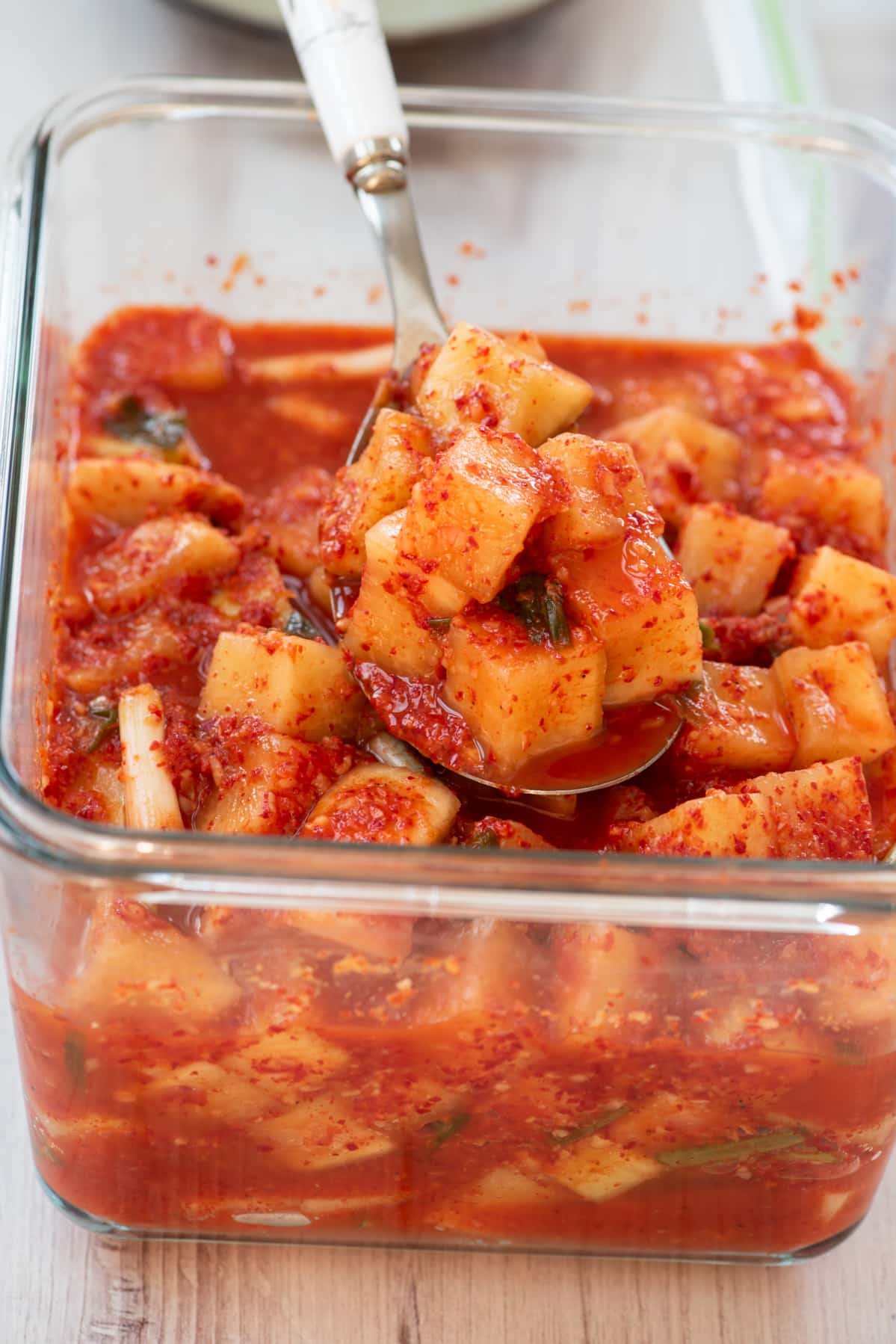Crunchy, spicy, and deeply savory, kkakdugi is a highly popular Korean radish kimchi. And easy to make!
Kkakdugi (깍두기) is a kimchi made with Korean radish, mu (or moo, 무). The name kkakdugi comes from how the radish is cut — cubed, and it’s known as cubed radish kimchi in English.
Korean radish is a variety of white radish and has firm, crisp flesh and a slightly sweet and peppery taste. It’s a cool weather vegetable, so it tastes best in fall and winter. Summer radish can be bitter. You can add extra sweetener such as sugar and/or Korean plum syrup (maesilcheong, 매실청), if available, to balance out the bitterness.
How to make cubed radish kimchi
Ingredients
- Korean radishes, mu (무)
- Korean coarse sea salt (굵은소금) – See the recipe note for using other type of salt.
- scallions
- gochugaru (고추가루)
- myulchiaekjeot (멸치액젓), fish sauce – use salt or Korean soup soy sauce as a substitute
- saeujeot (새우젓), salted shrimp — use more fish sauce and/or salt to taste as substitutes
- garlic
- ginger
- Korean/Asian pear or apple – optional
- cooked rice (heated) – optional
- salt and/or sugar as needed
Saeujeot (새우젓, salted and fermented shrimp) and myulchiaekjeot (멸치액젓, fish sauce made with anchovies) are the classic ingredients in kimchi. These add the depth of flavors to kimchi. If salted shrimp is unavailable, you can use a little more fish sauce.
If neither is an option, use salt to season or Korean soup soy sauce (gukganjang, 국간장) in combination with salt.
When using the optional fruit and/or rice, you can blend them together with garlic and ginger.
Cutting the radish
Cut the radish into 3/4 to 1-inch thick discs first. Then cut each disc into the same thickness, 3 or 4 equal sticks, depending on the diameter. Turn the whole thing 90 degrees and then cut again into 3/4 to 1-inch cubes.
Salting
Radishes are 90 some percent water, and salting draws out some of their water content for a crunchy texture of kimchi.
Koreans use coarse sea salt for kimchi, but if not available to you, use what you have. You will need to use less if using finer salt. This recipe uses 3 TBS of Korean coarse sea salt, which, for example, is approximately equivalent to 2.5 TBS of coarse Kosher salt or 2 tablespoons of Morton’s canning and pickling salt, which is very fine grain salt.
Sprinkle the salt over the radishes and toss well to distribute the salt. The moisture from the radish dissolves the salt quickly. Let it sit for about an hour, tossing them to rotate once or twice every 20 minutes or so. More salt or longer salting will draw out more water.
Draining
The radishes should have released quite a bit of water after being salted. Drain the radishes. Do NOT rinse them and wash off the salt on the surfaces. Discard the drained water! It’s too salty to use, because we are using other salty ingredients.
However, if you’re not using salted shrimp and/or fish sauce, reserve this salt water and use some of it to season the kimchi.
Mix with Seasonings
Add the gochugaru, and mix well to coat the radish cubes and rub with your hand. This gives the radish kimchi a nice red color. Then, add the remaining ingredients and mix really well before tossing in the scallions.
Storing and fermenting
Radish kimchi takes longer to ferment than napa cabbage kimchi. Leave the kkakdugi at room temperature for 2 to 3 days during cold months, depending on your actual room temperature and how soon you want to start eating your kimchi. Then keep it in the fridge. It will continue to ferment.
You can enjoy kkakdugi with any Korean meal, but it’s especially good with a bowl of mild soup such as seolleongtang, samgyetang, galbitang, and dak gomtang. It’s a delicious side dish that will add a robust, spicy kick and some crunch to a meal!
Watch how to make it
More kimchi recipes
15 Easy Kimchi Recipes
For more Korean cooking inspirations, follow along on YouTube, Pinterest, Twitter, Facebook, and Instagram.

Kkakdugi (Cubed Radish Kimchi)
Side Dish
Servings: 48
Print Recipe
Notes
2. If Korean coarse sea salt is unavailable, 3 TBS of Korean coarse sea salt, for example, is approximately equivalent to 2.5 TBS of coarse Kosher salt or 2 tablespoons of Morton’s canning and pickling salt, which is very fine grain salt.
3. If salted shrimp is not available, you can use a little more fish sauce. If neither is an option, use salt to season or Korean soup soy sauce (gukganjang, 국간장) in combination with salt.
4. If using optional fruit and/or cooked rice, blend them with garlic and ginger. Add some water (about 1/2 cup) for easier blending.

